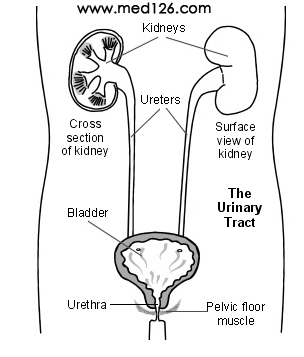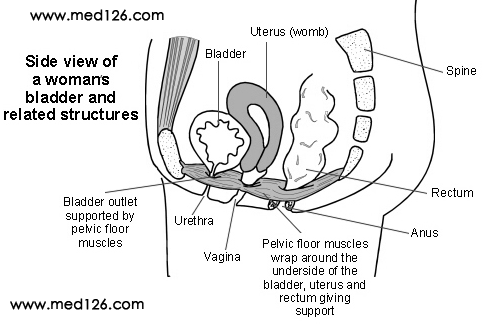

The kidneys make urine all the time. A trickle of urine is constantly passing to the bladder down the ureters (the tubes from the kidneys to the bladder). You make different amounts of urine depending on how much you drink, eat and sweat.
The bladder is made of muscle and stores the urine. It expands like a balloon as it fills with urine. The outlet for urine (the urethra) is normally kept closed. This is helped by the muscles beneath the bladder that sweep around the urethra (the pelvic floor muscles). When a certain amount of urine is in the bladder, you become aware that the bladder is getting full. When you go to the toilet to pass urine, the bladder muscle contracts (squeezes), and the urethra and pelvic floor muscles relax.
Complex nerve messages are sent between the brain, the bladder, and the pelvic floor muscles. These tell you how full your bladder is, and tell the right muscles to contract or relax at the right time.
What is stress incontinence?
Stress incontinence is when urine leaks when there is a sudden extra pressure ('stress') on the bladder. Urine leaks because your pelvic floor muscles and urethra cannot withstand the extra pressure. (The diagram below shows how the pelvic floor muscles support the bladder and nearby structures.) The incontinence develops because the pelvic floor muscles are weakened. Small amounts of urine may leak, but sometimes it can be quite a lot.
Urine tends to leak most when you cough, laugh, or when you exercise (like when you jump or run). In these situations there is sudden extra pressure within the abdomen and on the bladder.
How common is stress incontinence?
Stress incontinence is the most common form of urinary incontinence. It is estimated that about three million people in the UK are regularly incontinent. Overall this is about 4 in 100 adults, and well over half of these are due to stress incontinence. Stress incontinence becomes more common in older women and as many as 1 in 5 women over the age of 40 have some degree of stress incontinence.
The second most common type of incontinence is urge incontinence which is dealt with in a separate leaflet. Briefly, urge incontinence is when you get an urgent desire to pass urine from an 'overactive bladder'. Urine may leak before you have time to get to the toilet. Treatment is different to stress incontinence. Some people have both stress incontinence and urge incontinence.医学.全在线www.med126.com
There are other less common causes of incontinence. Note: you should always see your doctor if you develop incontinence. There are different causes of incontinence, and each cause has different treatments. Your doctor will assess you to determine the cause and advise on possible treatment options. See separate leaflet called 'Urinary Incontinence' for a general overview. The rest of this leaflet is only about stress incontinence in women.
What causes stress incontinence?

Most cases of stress incontinence are due to weakened pelvic floor muscles. The common reason for the pelvic floor muscles to become weakened is childbirth. The pelvic floor muscles are a group of muscles that wrap around the underside of the bladder and rectum. Stress incontinence is common in women who have had children. It is also more common with increasing age as the muscles become weaker, particularly after the menopause. Stress incontinence is also more common in women who are obese.
What are the treatment options for stress incontinence?
The usual first treatment is to strengthen the pelvic floor muscles. About 6 in 10 cases of stress incontinence can be cured or much improved with this treatment. Medication may be advised in addition to pelvic floor exercises in some cases. Surgery may be advised if the problem persists and other treatments have not worked well.
Strengthening the pelvic floor muscles - 'pelvic floor exercises'
It is important that you exercise the correct muscles. Your doctor may refer you to a continence advisor or physiotherapist for advice on the exercises. The sort of exercises are as follows.